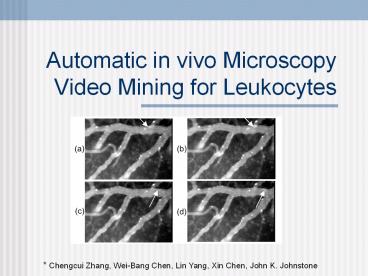Automatic in vivo Microscopy Video Mining for Leukocytes - PowerPoint PPT Presentation
Title:
Automatic in vivo Microscopy Video Mining for Leukocytes
Description:
Automatic in vivo Microscopy Video Mining for Leukocytes * Chengcui Zhang, Wei-Bang Chen, Lin Yang, Xin Chen, John K. Johnstone Background Information What is in vivo ... – PowerPoint PPT presentation
Number of Views:112
Avg rating:3.0/5.0
Title: Automatic in vivo Microscopy Video Mining for Leukocytes
1
Automatic in vivo Microscopy Video Mining for
Leukocytes
Chengcui Zhang, Wei-Bang Chen, Lin Yang, Xin
Chen, John K. Johnstone
2
Background Information
- What is in vivo microscopy?
- Images of the cellular and molecular processes in
a living organism - Why video-mine leukocytes?
- To Predict Inflammatory response
- Rolling velocity and magnitude of adhesion of
leukocytes are the main predictors - Currently analyzed manually
- Time consuming / Expensive
- Subjective
3
Objectives
- Given a sequence of in vivo images,
- Track the moving leukocytes
- Calculate their average velocity
- Find the magnitude of adherent leukocytes
4
Challenges
- Server Noise
- Background movement
- Due to movement of the living organism
- Deformation of leukocytes
- Change of contrast in different frames
5
Previous Work
- Eden et al. use local features (e.g. color) for
a tracking system - Assume that leukocytes roll along the vessel
centerline - Acton et al. Background removal
morphological filter - Assumes the shape/size leukocytes does not change
6
Suggested Approach
- Three main steps
- Frame Alignment
- To correct the camera/subject movement
- Detect Moving Leukocytes
- Detect Adherent Leukocytes
- After moving leukocytes are removed
7
Step 1- Frame Alignment
- 1.1- Detect Camera/Subject Movement
- Define a (dis)similarity measure between
consecutive frames
- This allows for some tolerance within radius r
- If S(ft-1, ft) is larger than a threshold, then
ft requires frame alignment
8
Step 1- Frame Alignment
- 1.2- Frame Matching
- Generate a number of high dimensional, local
scale-invariant features SIFT for the frame and
its predecessor - Use nearest-neighbor to find a match for each
feature point - Calculate the transformation matrix H, such that
- For every matched point x and x
9
Step 1- Frame Alignment
- Use Random Sample Consensus (RANSAC) to correct
the mismatches
10
Step 2 - Detecting Moving Leukocytes
- Approach 1 - Probabilistic Learning
- For pixel j in the image, let x1j, x2j, ..., xNj
be the intensity of the pixel over N frames - Assume that P(xtj) has a normal distribution over
time with mean xtj
- If P(xtj) is smaller than a threshold, then it is
a foreground pixel - Problem Difficult to find a threshold
11
Step 2 - Detecting Moving Leukocytes
- Approach 1 - Probabilistic Learning
- Problem Difficult to find the threshold value
- Solution Use One-Class SVM to classify
background and foreground pixels
12
Step 2 - Detecting Moving Leukocytes
- Approach 2 - Neural Network
- Train a neural net to learn the predictable
pattern of the background pixels - Input x(t-m), x(t-m1),... , x(t-1)
- A sliding window of the intensity sequence
- Output x(t)
- Prediction for the intensity of the pixel at the
next frame - If the neural-net prediction and the real pixel
intensity are very different, the pixel in the
current frame is in foreground
13
Step 2 - Detecting Moving Leukocytes
- Approach 2 - Neural Network
14
Step 2 - Detecting Moving Leukocytes
- Calculating the leukocytes velocity
- Find the centroid of each group of connected
foreground pixels - For each centroid, find the closest centroid in
the previous frame - If their distance is smaller than a threshold,
they are a match - Compute the mean velocity
15
Step 3- Detecting Adherent Leukocytes
- First, remove the moving leukocytes
- Three main types of regions left
- Tissues
- Vessels
- Adherent Leukocytes
- These three have different intensity values
16
Step 3- Detecting Adherent Leukocytes
17
Step 3- Detecting Adherent Leukocytes
- Finding the threshold values
- Fit an 8th degree polynomial to the histogram
curve - The real part of the second largest root is the
ideal threshold - Justification?
- Problem with false positives and false negatives
18
Experimental Results
- Test video of 148 frames
- Detecting moving leukocytes
- 1 false positive for probabilistic learning(?)
- 49 false positive for neural-net approach
- 50 recall
- Detecting Adherent leukocytes
- 2 false positive
- 95 recall
19
Final Remarks
- Paper is mainly related to Vision
- The algorithms require many magic parameters
that need hand tuning - Would the current parameters work as well for a
new video sequence from a new equipment? - Do we want to pursue more video-mining papers?































